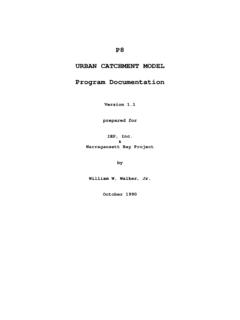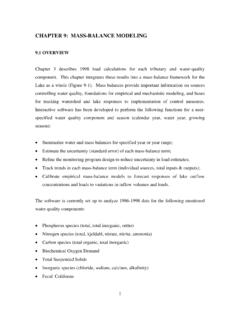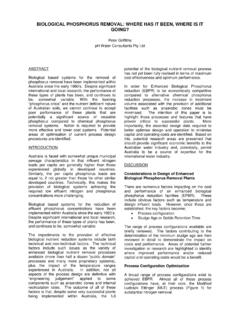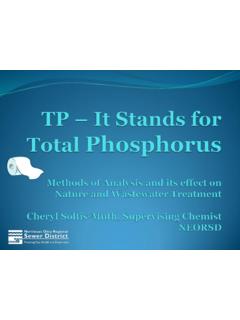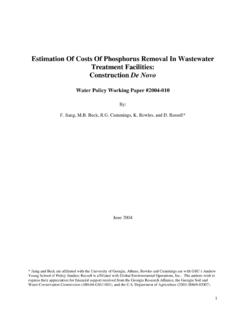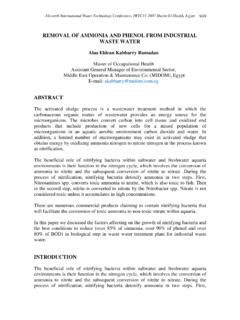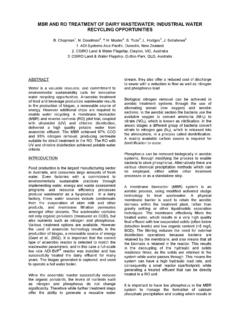Transcription of Role of sediment and internal loading of phosphorus in ...
1 Hydrobiologia506 509:135 145, 2003. 2003 Kluwer Academic Publishers. Printed in the of sediment and internal loading of phosphorus in shallow lakesMartin S ndergaard, Jens Peder Jensen & Erik JeppesenNational Environmental Research Institute, Department of Freshwater Ecology, Vejls vej 25, Box 314, DK-8600 Silkeborg, DenmarkE-mail: words:biomanipulation, iron, recovery, redox, release mechanisms, retentionAbstractThe sediment plays an important role in the overall nutrient dynamics of shallow lakes. In lakes where the externalloading has been reduced, internalphosphorus loading may prevent improvements in lake water quality.
2 At highinternal loading , particularly summer concentrations rise, and phosphorus retention can be negative during most ofthe summer. internal P loading originates from a pool accumulated in the sediment at high external loading , andsignificant amounts of phosphorus in lake sediments may be bound to redox-sensitive iron compounds or fixed inmore or less labile organic forms. These forms are potentially mobile and may eventually be released to the lakewater. Many factors are involved in the release of phosphorus . Particularly the redox sensitive mobilization from theanoxic zone a few millimetres or centimetres below the sediment surface and microbial processes are consideredimportant, but the phosphorus release mechanisms are to a certain extent lake specific.
3 The importance of internalphosphorus loading is highly influenced by the biological structure in the pelagic, and lakes shifting from a turbid toa clearwater state as a result of, for example, biomanipulation may have improved retention considerably. However, internal loading may increase again if the turbid state returns. The recovery period following a phosphorus loadingreduction depends on the loading history and the accumulation of phosphorus in the sediment , but in some lakesa negative phosphorus retention continues for decades. phosphorus can be released from sediment depths as lowas 20 cm.
4 The internal loading can be reduced significantly by various restoration methods, such as removal ofphosphorus-rich surface layers or by the addition of iron or alum to increase the sediment s sorption availability is regarded as the most im-portant factor for determining the water quality oflakes. Numerous studies have shown that high loadingof phosphorus leads to high phytoplankton biomass,turbid water and often undesired biological latter includes loss of biodiversity, disappear-ance of submerged macrophytes, fish stock changes,and decreasing top-down control by zooplankton order to reverse the eutrophication of lakes,much effort has been made to reduce the external load-ing of phosphorus .
5 Some lakes respond rapidly to suchreductions (Sas, 1989), but a delay in lake recovery isoften seen (Marsden, 1989; Jeppesen et al., 1991; vander Molen & Boers, 1994), one of the reasons beingthat phosphorus accumulated in the sediment duringthe period of high loading needs time to equilibratewith the new loading level. phosphorus release fromthe sediment into the lake water may be so intenseand persistent that it prevents any improvement of wa-ter quality for a considerable period after the loadingreduction (Gran li, 1999; Scharf, 1999).Compared to deep lakes where a redox depend-ent accumulation of phosphorus occurs in the anoxichypolimnion during stratification, shallow lakes areusually well mixed and oxidized throughout the wa-ter column.
6 Nonetheless, the sediment of shallowlakes has often been demonstrated to release phos-phorus to oxic lake water (Lee et al., 1977; Bostr met al., 1982; Jensen & Andersen, 1992), suggest-ing that other factors than redox conditions at thesediment water interface are involved. The import-ance of sediment water interactions in shallow lakesis furthermore enhanced by the high sediment sur-136face:water column ratio, which means that the poten-tial influence on lake water concentrations is strongerthan in deeper lakes. The direct contact with the photiczone throughout the year and the regular mixing re-gime guarantee stable and near optimum conditionsfor primary production (Nixdorf & Deneke, 1995).
7 Often the phosphorus pool in the sediment is morethan 100 times higher than the pool present in the lakewater, and lake water concentrations therefore dependhighly on the sediment water this paper we give a short review of the phos-phorus retention in lake sediments and the mechan-isms and factors suggested to be vital to phosphorusrelease from lake sediments. Our aim is to show thatthe sediment of shallow lakes is the domicile of nu-merous highly dynamic processes that may have verysubstantial effects on the total phosphorus budget andlake water and phosphorus in the sedimentRetention of phosphorusDuring steady state conditions a certain amount of thephosphorus entering a lake is retained in the sediment (Fig.)
8 1). The retention percentage depends on the hy-draulic retention time, as demonstrated through differ-ent simple, empirically established models of the Vol-lenweider type: Plake=Pin/(1+ ), relating in-lakephosphorus (Plake) to inlet concentrations (Pin)andhydraulic residence time (tw) (Vollenweider, 1976;OECD, 1982). These models cannot, however, ad-equately describe the transient phase after reducedloading when the system is not in equilibrium andstrongly influenced by the internal loading of phos-phorus. The net retention of phosphorus is the differ-ence between two processes with large opposite direc-ted flux rates: (i) the downward flux caused mainlyby sedimentation of particles continuously enteringthe lake or produced in the water column (algae, de-tritus etc.
9 And (ii) the upwards flux or gross releaseof phosphorus driven by the decomposition of organicmatter and the phosphorus gradients and transportmechanisms established in the sediment . Phosphorussedimentation from the lake water can be enhancedin productive lakes via co-precipitation with calciumcarbonate (House et al., 1986; Driscoll et al., 1993;Golterman, 1995; Hartley et al., 1997).The importance of internal loading of phosphorusduring lake recovery is demonstrated by the findingthat phosphorus concentrations often increase duringsummer in shallow eutrophic lakes (Sas, 1989; Phil-lips et al.)
10 , 1994; Welch & Cooke, 1995; Ekholm etal., 1997). In most cases this increase can only bethe result of increased sediment loading , implying thatsummer phosphorus concentrations are largely con-trolled by internal processes (Jeppesen et al., 1997;Ramm & Scheps, 1997; Kozerski & Kleeberg, 1998).The most pronounced impact is often found in themost eutrophic lakes in which summer concentrationstypically exceed winterconcentrations by 200 300%from June until October (S ndergaard et al., 1999).Mass balance calculations have shown that phos-phorus retention exhibits a seasonal pattern mimickingthe seasonal variation in lake water phosphorus .
